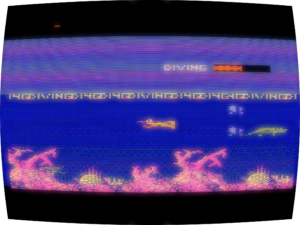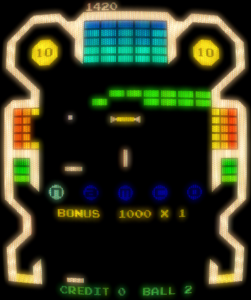 The Game: Two players’ vehicles start in opposite corners of a confined grid; when moved, each vehicle leaves a light cycle-style trail of that player’s color (red or gold) in its wake. But here’s the twist: the players won’t be eliminated by running over the opponent’s “wake.” Instead, running over the other player’s wake once will knock that portion of it down; running over the resulting gap refills that space with your color instead. The object of the game is to occupy as much of the grid as possible by the end of 45 seconds. (Each game consists of three 45-second rounds, and each successive round adds obstacles such as walls, or gaps through which players’ vehicles can fall, resulting in a delay while that vehicle is replaced.) The winner of the best two out of three rounds wins the game. (1985, Bally [under license from Sente Ltd.] – unreleased)
The Game: Two players’ vehicles start in opposite corners of a confined grid; when moved, each vehicle leaves a light cycle-style trail of that player’s color (red or gold) in its wake. But here’s the twist: the players won’t be eliminated by running over the opponent’s “wake.” Instead, running over the other player’s wake once will knock that portion of it down; running over the resulting gap refills that space with your color instead. The object of the game is to occupy as much of the grid as possible by the end of 45 seconds. (Each game consists of three 45-second rounds, and each successive round adds obstacles such as walls, or gaps through which players’ vehicles can fall, resulting in a delay while that vehicle is replaced.) The winner of the best two out of three rounds wins the game. (1985, Bally [under license from Sente Ltd.] – unreleased)
Memories: After being “put on the beach” by Atari’s new Warner Bros.-controlled management – a term meaning that he was out the door, but still receiving money from a bonus pool that, in Atari’s heyday, was quite substantial – founder Nolan Bushnell was left at a loose end in more ways than one. He began building his new empire, a chain of franchise restaurants called Chuck E. Cheese’s Pizza Time Theatre, which combined food service, robotic characters whose technology Atari had no interest in pursuing and therefore allowed him to retain, and arcade games. Bushnell was still eager to have something to do with the video game industry, but a non-compete clause literally took him out of that game for seven years. In 1985, that clause expired, and Bushnell was ready to get back in the game.
 Calling his new game company Sente – the equivalent of “checkmate” in the Chinese game of Go, in which the term Atari had approximated “check” – Bushnell quickly absorbed a small game development house called Videa, which basically consisted of several former Atari employees working on both arcade game designs and home cartridges. Videa had numerous games in development when Sente took over, and Toggle is one of them.
Calling his new game company Sente – the equivalent of “checkmate” in the Chinese game of Go, in which the term Atari had approximated “check” – Bushnell quickly absorbed a small game development house called Videa, which basically consisted of several former Atari employees working on both arcade game designs and home cartridges. Videa had numerous games in development when Sente took over, and Toggle is one of them.
In several respects, Toggle is indicative of the arcade industry’s struggle to stay above water while the home video game market was going under. Toggle isn’t that inventive – its lineage goes back to B&W arcade games of the 70s which introduced the  concept that Tron would later appropriate as the light cycle game. Even once it introduces obstacles such as the gaps that the players can fall into, Toggle is then appropriating elements of Motos, a very minor Namco hit which also arrived in 1985.
concept that Tron would later appropriate as the light cycle game. Even once it introduces obstacles such as the gaps that the players can fall into, Toggle is then appropriating elements of Motos, a very minor Namco hit which also arrived in 1985.
That being said, none of this makes Toggle less fun. A relatively unique element of the game is that it’s structured like a mini-sporting event, with a finite number of rounds and a finite length to each round. (As Toggle died in the prototype stage and never actually made it to the arcade, it’s unknown whether or not that particular element fared well with play-testers, or even if it would have been retained for the final release.) That turns the already-familiar components of the game into a ticking time bomb of sorts, and does away with  the arcade cliché of three or four “lives.” (Indeed, as I found out while playing one rather unfortunate game of Toggle in MAME, you can clumsily send your vehicle into the gaping holes in the third stage as many times as you like, and you never run out of ships. You lose, yes, but you never run out of ships!)
the arcade cliché of three or four “lives.” (Indeed, as I found out while playing one rather unfortunate game of Toggle in MAME, you can clumsily send your vehicle into the gaping holes in the third stage as many times as you like, and you never run out of ships. You lose, yes, but you never run out of ships!)
The power-up element also introduces something relatively new to things, including a “flip flop” power up that reverses the territory each player has claimed; if you hit that power-up while you’re way behind in the game, you can suddenly find yourself winning a round that you were miserably losing just a second before. If you accidentally hit it while you’re ahead, you might as well walk away for the remainder of that round, and slap your forehead a few times.
But all of these elements, to some degree, had been seen in other games. Would Toggle have made a dent in the arcade? At the time, game concepts were changing radically, and the repeat-and-amend-what-someone-else-already-did methodology that was seen in the early  80s wasn’t cutting it anymore. 1985 was already seeing adventurous platform games taking off (Super Mario Bros., Pac-Land), games with much more dazzling graphics and other
80s wasn’t cutting it anymore. 1985 was already seeing adventurous platform games taking off (Super Mario Bros., Pac-Land), games with much more dazzling graphics and other  gimmicks (Atari’s three-monitor TX-1 first-person racer, licensed from Namco), and laserdisc games were still clinging on tenaciously. Though fun, Toggle didn’t bring enough new elements to the table to draw the kind of attention needed for repeat business, which makes or breaks arcade games that live or die by coin drop.
gimmicks (Atari’s three-monitor TX-1 first-person racer, licensed from Namco), and laserdisc games were still clinging on tenaciously. Though fun, Toggle didn’t bring enough new elements to the table to draw the kind of attention needed for repeat business, which makes or breaks arcade games that live or die by coin drop.


